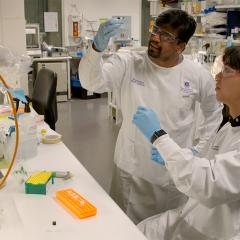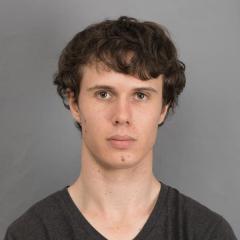We use the Drosophila model to address complex questions in neuroscience, such as perception and subjective awareness.
The van Swinderen laboratory uses the fruit fly model Drosophila melanogaster to understand mechanisms underlying consciousness.
Three questions are studied in particular: how do general anaesthetics work? why do we sleep? and, how does a brain pay attention?
These complex questions are typically studied in humans but can be effectively addressed in the smallest of animal brains. By combining powerful molecular genetic tools with behavioural assays, electrophysiology, brain imaging, we are able to uncover the underpinnings of these complex phenomena relevant to understanding consciousness. To pay attention, learn, and sleep, a brain must be able to suppress or prioritise parts of the outside world effectively, yet some drugs abolish this in seconds. To understand these complex mechanisms requires linking local effects on molecules and neurons with global, brain-wide consequences. Drosophila research offers a realistic model to make those links, in order to understand how healthy brains work but also how they might fail in disease.
Although sleep and attention might seem very different to us, it is possible that both phenomena involve similar plasticity mechanisms in the brain. This hypothesis, guides several projects in the lab, where the effects of sleep on attention (and vice versa) are investigated in the fruit fly model. Our discovery that flies sleep in different stages, with distinct kinds of brain activity, allows to now exploit the powerful Drosophila model to understand the many functions of sleep. Accordingly, our sleep research is aimed at understanding how distinct sleep stages might be accomplishing entirely different functions, but also how a brain knows exactly what kind of sleep it needs. By understanding how sleep naturally maintains brain health, we should be able to better design strategies targeting specific sleep functions aimed at correcting different kinds of brain disorders.
Our work on general anaesthesia is largely focussed on understanding a new mechanism that we have discovered for these drugs. We have found that common general anaesthetics such as propofol impair presynaptic release of neurotransmitters, in addition to acting on postsynaptic receptors. The laboratory is actively involved in understanding the molecular mechanisms underlying this effect on neurotransmission, with a view to developing novel tools to render a brain unconscious and unresponsive. This aligns with our larger research goal of understanding consciousness by turning it off.
Group leader

Professor Bruno van Swinderen
Group Leader, Drosophila behaviour and cognition
Principal Research Fellow - GL
+61 7 334 66332
b.vanswinderen@uq.edu.au
UQ Researcher Profile
Our long-term vision is to understand how a brain produces subjective awareness. To achieve this long-term goal, we have focussed on understanding three brain states where awareness can be lost: general anaesthesia, sleep, and selective attention. During selective attention, we become unaware of objects outside our focus. How does that work? During sleep, the outside world is more broadly suppressed. Why is this necessary? Finally, during general anaesthesia, a bewildering array of drugs achieve the same, but deeper. By studying these three ways in which consciousness is lost, we hope to arrive at a better understanding on what is necessary for consciousness to exist – in any animal.
General anaesthetics do more than put you to sleep
- van Swinderen, Bruno and Kelz, Max B. (2022). Anesthesia: Synaptic power failure. Current Biology, 32 (14), R781-R783. doi: 10.1016/j.cub.2022.06.043
- Van De Poll, Matthew N. and van Swinderen, Bruno (2021). Balancing prediction and surprise: A role for active sleep at the dawn of consciousness?. Frontiers in Systems Neuroscience, 15 768762, 768762. doi: 10.3389/fnsys.2021.768762
- Hines, Adam D. and van Swinderen, Bruno (2021). Tracking single molecule dynamics in the adult Drosophila brain. eNeuro, 8 (3) ENEURO.0057-21.2021, ENEURO.0057-21.2021. doi: 10.1523/eneuro.0057-21.2021
- Melnattur, Krishna, Kirszenblat, Leonie, Morgan, Ellen, Militchin, Valentin, Sakran, Blake, English, Denis, Patel, Rushi, Chan, Dorothy, van Swinderen, Bruno and Shaw, Paul J. (2021). A conserved role for sleep in supporting Spatial Learning in Drosophila. Sleep, 44 (3) zsaa197, 1-14. doi: 10.1093/sleep/zsaa197
- Leung, Angus, Cohen, Dror, Van Swinderen, Bruno and Tsuchiya, Naotsugu (2021). Integrated information structure collapses with anesthetic loss of conscious arousal in Drosophila melanogaster. PLoS Computational Biology, 17 (2) e1008722, e1008722. doi: 10.1371/JOURNAL.PCBI.1008722
Tainton-Heap, L., Kirszenblat, L., Notaras, E., Grabowska, M., Jeans, R., Feng, K., Shaw, P., van Swinderen, B. (2020) A paradoxical kind of sleep in Drosophila. Current Biology (in press).
Grabowska, M., Jeans, R., Steeves, J., van Swinderen, B. (2020) Oscillations in the central brain of Drosophila are phase locked to attended visual features. Proceedings of the National Academy of Sciences (USA) (in press)
Karunanithi, S., Lin, Y-Q., Odierna, L., Menon, H., Gonzalez, J., Noakes, P., Lavidis, N., Neely, G., Moorhouse, A., van Swinderen, B. (2020) Activity-dependent global downscaling of evoked neurotransmitter release across glutamatergic inputs in Drosophila. Journal of Neuroscience 40(42): 8025-8041.
Melnattur, K., Kirszenblat, L., Morgan, E., Militchin, V. Sakran, B., English. D., Patel, R., Chan, D., van Swinderen, B., Shaw. P. (2020) A conserved role for sleep in supporting spatial learning in Drosophila. Sleep 21: zsaa197.
Ertekin, D., Kirszenblat, L., Faville, R. van Swinderen, B. (2020) Downregulation of a cytokine secreted from peripheral fat bodies improves visual attention while reducing sleep in Drosophila. PLoS Biology. 18(8): e3000548.
Carter, O., van Swinderen, B., Leopold, D., Collin, S., Maier, A. (2020) Perceptual rivalry across animal species. Journal of Comparative Neurology (in press, May 2020).
Karunanithi, S., Cylinder, D., Ertekin, D., Zalucki, O., Marin, L., Lavidis, N., Atwood, H., van Swinderen, B. (2020) Proportional downscaling of glutamatergic release sites by the general anesthetic propofol at Drosophila motor nerve terminals. eNeuro 7(1).
Troup M, Zalucki OH, Kottler,BD, Karunanithi S, Anggono V, van Swinderen B. (2019) Syntaxin1A neomorphic mutations promote rapid recovery from isoflurane anesthesia in Drosophila melanogaster. Anesthesiology 131(3): 555-568.
Kirszenblat L, Yaun, R., van Swinderen B. (2019) Visual experience drives sleep need in Drosophila. Sleep 42(7): zsz102.
Kirszenblat L, Ertekin D, Goodsell J, Zhou Y, Shaw PJ, van Swinderen B. (2018) Sleep regulates visual selective attention in Drosophila. Journal of Experimental Biology. Dec 14; 221(Pt 24) . pii: jeb.191429.
Grabowska MJ, Steeves J, Alpay J, Van De Poll M, Ertekin D, van Swinderen B. (2018) Innate visual preferences and behavioral flexibility in Drosophila. Journal of Experimental Biology.Dec 5;221(Pt 23). pii: jeb185918.
Troup M, Yap MH, Rohrscheib C, Grabowska MJ, Ertekin D, Randeniya R, Kottler B, Larkin A, Munro K, Shaw PJ, van Swinderen B. (2018) Acute control of the sleep switch in Drosophila reveals a role for gap junctions in regulating behavioral responsiveness. eLife. Aug 15;7. pii: e37105
Bademosi, A.T., Steeves, J., Karunanithi, S., Zalucki, O.H., Gormal, R.S., Liu, S., Lauwers, E., Verstreken, P., Anggono, V., Meunier, F.A., van Swinderen, B. (2018) Trapping of syntaxin1A in presynaptic nanoclusters by a clinically relevant general anesthestic. Cell Reports 22(2):427-440
Yap, M.H.W., Grabowska, M.J., Rohrscheib, C., Jeans, R., Troup, M., Paulk, A.C., van Alphen, B., Shaw, P.J., van Swinderen, B. (2017) Oscillatory brain activity in spontaneous and induced sleep stages in flies. Nature Communications 8(1):1815.
Zalucki, O., van Swinderen, B. (2016) What is unconsciousness in a fly or a worm? A review of general anesthesia in different animal models. Consciousness and Cognition 44: 72-88.
De Bivort, B.L., van Swinderen, B. (2016) Evidence for selective attention in the insect brain. Current Opinion in Insect Science 15: 9-15.
Kirszenblat, L., van Swinderen, B. (2015) The yin and yang of sleep and attention. Trends in Neurosciences. 38: 776-86.
Paulk, A.C., Kirszenblat, L., Zhou, Y-Q, van Swinderen, B. (2015) Closed-loop behavioral control increases coherence in the fly brain. Journal of Neuroscience 35: 10304-15.
Dissel, S., Angadi, V., Kirszenblat, L., Suzuki, Y., Donlea, J., Klose, M., Koch, Z., English, D., Winsky-Sommerer, R., van Swinderen, B., Shaw, P.J. (2015) Sleep restores plasticity to Drosophila mutants. Current Biology 25: 1270-81.
Kottler, B., Bao, H., Zalucki, O., Troupe, M., Imlach, W. Paulk, A., van Alphen, B., Zhang, B., van Swinderen, B. (2013) A sleep/wake circuit controls isoflurane sensitivity in Drosophila. Current Biology 23: 594-8.
van Alphen, B., Yap, M., Kirszenblat, L., Kottler, B., van Swinderen, B. (2013) A dynamic deep sleep stage in Drosophila. Journal of Neuroscience 33: 6917-27
Recent breakthroughs:
2020: Selective attention in the fly brain!
2020: Flies have an active sleep stage!
2018: A new mechanism for general anaesthesia!
10/1/18 [INTERNATIONAL – ONLINE] – COSMOS – “General anaesthetic more than just a super sleeping pill”https://cosmosmagazine.com/biology/general-anaesthetic-more-than-just-a-super-sleeping-pill
10/1/18 [INTERNATIONAL – ONLINE] – SCIENCE ALERT – “Scientists Just Changed Our Understanding of How Anaesthesia Messes With The Brain” http://www.sciencealert.com/how-general-anaesthetic-works-new-discovery-propofol-syntaxin1a-neuron-disruption
10/1/18 [INTERNATIONAL – ONLINE] – BIOSCIENCE – “How do general anaesthetics work? Scientists may have finally found the answer” http://www.alphr.com/bioscience/1008148/general-anaesthetic-side-effects-risks-brain
10/1/18 [INTERNATIONAL – ONLINE] – MedicalNewsToday – “How general anesthetics affect the brain” https://www.medicalnewstoday.com/articles/320564.php
10/1/18 [NATIONAL – ONLINE] SMH – “It's a knockout, but so much more: Unravelling the mystery of anaesthetic” - http://www.watoday.com.au/queensland/it-s-a-knockout-but-so-much-more-unravelling-the-mystery-of-general-anaesthetic-20180109-p4yycs.html
10/1/18 [STATE – ONLINE] WA NEWS – “It's a knockout, but so much more: Unravelling the mystery of anaesthetic” -http://www.watoday.com.au/queensland/it-s-a-knockout-but-so-much-more-unravelling-the-mystery-of-general-anaesthetic-20180109-p4yycs.html
10/1/18 [STATE – ONLINE] BRISBANE TIMES – “It's a knockout, but so much more: Unravelling the mystery of anaesthetic” -https://www.brisbanetimes.com.au/national/queensland/it-s-a-knockout-but-so-much-more-unravelling-the-mystery-of-general-anaesthetic-20180109-p4yycs.html
- Electrophysiology in behaving animals
- 2-photon microscopy in behaving animals
- Super-resolution microscopy and analysis techniques
- Behavioural assays assays in freely-walking and tethered flies
- Sleep behaviour and analysis in Drosophila flies
- Molecular biology and genomic analysis
- Matlab programming
Our approach
Our strategy is to use the Drosophila model to address complex questions in neuroscience, such as perception and subjective awareness. We use a wide range of genetic and brain recording tools that are often uniquely available to the fly model.
Research areas
Selective attention
Selective attention refers to the brain’s capacity to prioritise one set of stimuli while ignoring others. This serial way of perceiving the world promotes learning and memory. Amazingly, even flies seem to pay attention to their world in a similar way, suggesting a common mechanism in all animal brains. We discovered that this common mechanism may be centred oscillatory neural activity in the brain. Dynamic oscillations in different frequency ranges (e.g., 20-30Hz ‘beta’ or 30-50Hz ‘gamma’) are evident when we record brain activity from flies attending to visual objects. Optogenetic approaches allow us to control specific circuits in the fly brain to understand how these oscillations work to help the brain pay attention. To study this, we have developed virtual reality visual environments for both tethered and freely-walking flies. We are especially interested in understanding how attention might be affected by sleep process.
Sleep
Although everyone spends about a third of their life sleeping, the function of sleep remains mysterious. Sleep deprivation is an increasing concern in modern societies, and deleterious effects of sleep deprivation on attention and performance can be as tragic as the consequences of excessive alcohol consumption. We have developed sleep models in Drosophila melanogaster and are investigating how sleep and attention are mechanistically related in the fly brain. We are as interested in understanding how sleep works to block out the world as what it’s for. We have recently discovered that, like many other animals, flies sleep in different stages. This includes a deep sleep stage that seems to be important for maintaining cellular health, as well as an ‘active’ sleep stage that helps flies pay better attention. Our findings suggest conservation of key sleep functions through evolution.
General anaesthesia
The mechanism of general anaesthesia remains unknown, despite almost 200 years since we began using these drugs for surgery. One reason the mechanism has remained so difficult to tackle lies in its complexity. We have discovered a new presynaptic mechanism for general anaesthesia centred on the neurotransmitter release machinery. Together with better understood post-synaptic receptor targets for these drugs, our finding potentially explains how these diverse mechanisms come together to produce the loss of consciousness that is required for surgery. We use a broad range of neuroscience techniques, from single molecule imaging and neuron recordings to whole brain imaging and behavioural analysis, to understand how general anaesthesia really works to render a brain completely unresponsive.
Latest news
Alumni
- Dr Travis Jeans
- Dr Bart van Alphen
- Dr Adekunle Bademosi
- Benjamin Calcagno
- Dr Dror Cohen
- Oliver Evans
- Dr Richard Faville
- Lachlan Fergusen
- Joseph Goodsell
- Dr Martyna Grabowska
- Dr Wendy Imlach
- Dr Leonie Kirszenblatt
- Dr Benjamin Kottler
- Dr Angelique Paulk
- Alice Petty
- Jacqui Stacey
- James Steeves
- Dr Melvyn Yap
- Dr Oressia Zalucki







